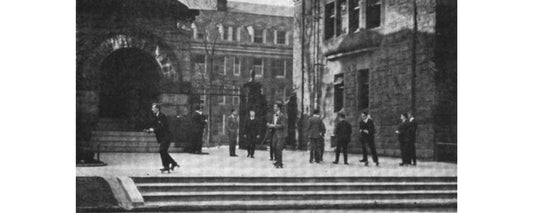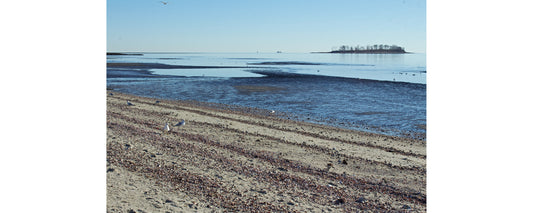“We are taking the town out of the 18th century and projecting it into the 21st.”
Even for a politician, that was a hyperbolic way of casting New Haven’s urban renewal program of the 1950s and ’60s. Spoken by the program’s metaphorical architect, Mayor Richard C. Lee (1916-2003), those words skipped right over New Haven’s prodigious 19th century when, in many respects—and far from being stuck in the 18th—the city’s inventive, industrious, intellectual denizens dragged much of the rest of the world into the 20th. They forgot that New Haven was long a manufacturing boomtown, a status it held through the early 1900s, when hundreds of local companies made goods as diverse as carriages, refrigerators, clothing, pharmaceuticals and industrial machinery. And they didn’t predict that by the early 21st century, the centerpieces of Lee’s urban renewal program—the Chapel Square Mall, the New Haven Coliseum, the Richard C. Lee Highway (a.k.a. the Oak Street Connector)—would be replaced, demolished and on the way out, respectively.
And yet, at the time Lee was running for mayor in 1949, and again in 1951 (when he lost by two votes), and again in 1953 (when he finally won), the nucleus of Lee’s perspective—that something drastic had to be done about New Haven—rang true. The Elm City was in decline. The proliferation of slums posed public health dangers and fostered crime. Its aging, outmoded infrastructure caused headaches and eyesores. The city’s legendary skilled manufacturing base, a buoyant source of jobs fueling growth and prosperity, was slumping. Indeed, New Haveners who could find opportunity elsewhere had been doing so for decades. Between 1920 and 1950, the city’s population failed to grow, the first period of generalized stagnation since the colonial era. During the same stretch, outlying towns saw their collective population increase by 250%.
On the other hand, Lee’s ascendance to the mayor’s office coincided with an era of burgeoning futurism in America, imbued with a new optimism about mankind’s ability to control its own destiny. This dovetailed with Lee’s own scrappy, bootstrapping story, including a pivotal moment when he’d had to make his own luck. Born in 1916, he grew up in Newhallville, part of a working-class family. His father, Frederick, was employed in the Winchester Repeating Arms Company factory; Richard worked as a delivery boy. After graduating from Hillhouse High in 1934, he bluffed his way through an interview with the New Haven Journal-Courier, landing a fate-shaping job as a city hall reporter.
Becoming intimately familiar with the workings and workers of city government, in 1939, at the tender age of 23, he ran for a seat on the Board of Aldermen and won. He briefly served in the army during World War II but was discharged in ’43 for medical reasons. Returning home to his city and its politics, he once again served as an alderman, also working for Yale at its Yale News Digest before being tapped to run the university’s public relations operation.
Then he won that election of 1953. Civic leaders including his predecessor, William Celentano, had had their eyes on outside money since the passage of the Federal Housing Act of 1949, which allocated funds for cities to demolish slums and build public housing. But Lee was the one who took that impulse and ran with it.
And far he ran. Over the course of his record-setting 16-year tenure, helped by his trusty, hard-nosed operative Edward J. Logue, the city obtained hundreds of millions of federal and state dollars, and not just to clear slums and build public housing. The Chapel Square Mall, since converted to a combination of residential, office and street-level retail space at 900 Chapel Street, was completed in 1967, becoming a busy retail hub that drew people from surrounding towns back into the city. The New Haven Coliseum, whose construction began in 1968 during Lee’s final term, and which is now the site of a large parking lot awaiting another round of redevelopment—this time as the “Downtown Crossing” project—was a large, popular entertainment venue before falling into disrepair. Wooster Square, which had been crumbling at the time of urban renewal, was renewed, and is now one of the city’s more desirable residential neighborhoods.
The Oak Street and Hill neighborhoods weren’t so lucky. The half-baked Route 34 Connector project—which, reflecting much of the city’s sentiment, the New Haven Independent took to calling the “mini-highway-to-nowhere”—leveled the former and effectively cut off the latter. Now on the chopping block itself, the connector is generally understood as an example of urban renewal gone terribly awry.
One of Lee’s most radical plans, intended to be the centerpiece of his redevelopment efforts, imagined a new government center around the New Haven Green. Amazingly, that plan would have removed the Ives Main Library, demolished the United States district courthouse and razed in its entirety City Hall itself. Thanks to preservationists who rallied against it in 1966, that plan never came to fruition.
Ironically, the judicial building was renamed the Richard C. Lee United States Courthouse in 1998; the library, taking its documentarian duties seriously, contains plenty of books referencing Lee; and Lee’s portrait, pictured above, hangs in City Hall, among those of New Haven’s other mayors. And if there were any question as to what Richard C. Lee wanted his mayoral legacy to be about, that portrait puts it to rest.
Painted next to the brown jacket sleeve covering his right arm, resting on a desk, is a set of blueprints.
Written by Cara Rosner. Photographed by Dan Mims. This story was originally published on November 7, 2014.







